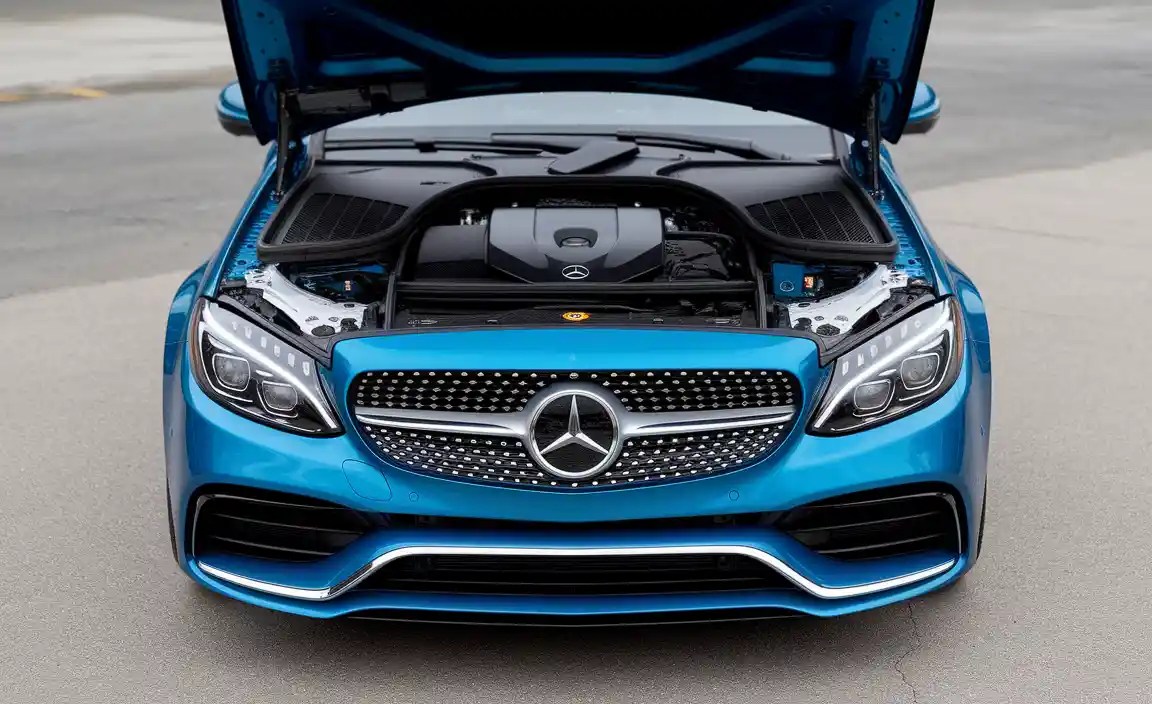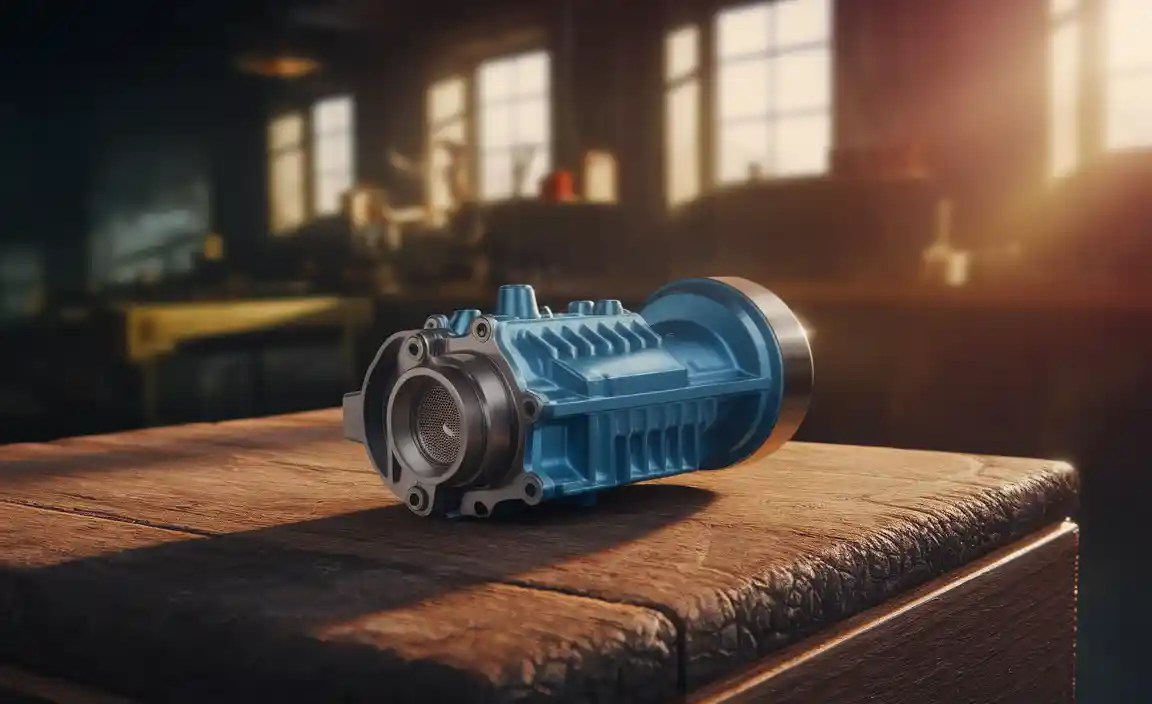Mercedes-Benz C Class Camshaft Sensor: Perfect Performance, Effortless Power
A C-Class camshaft sensor ensures your Mercedes runs smoothly by telling the engine computer the precise position of the camshafts. A faulty sensor can cause rough idling, poor fuel economy, and even engine stalling. Replacing it is a manageable DIY task that restores optimal performance and power.
Your Mercedes-Benz C-Class is a masterpiece of engineering, designed for refined performance and effortless power. But like any finely tuned machine, it relies on countless components working in perfect harmony. One such unsung hero? The camshaft sensor. When it’s functioning correctly, you enjoy that signature Mercedes smoothness.
But when it falters, you might notice a surprising dip in performance, a rougher idle, or even hesitation when you press the accelerator. Don’t worry, this is a common issue that many C-Class owners encounter. This guide will walk you through understanding, diagnosing, and ultimately replacing your C-Class camshaft sensor, bringing back that sublime driving experience.

Understanding the C Class Camshaft Sensor: The Brains Behind Your Benz’s Boost

In the intricate world of your Mercedes-Benz C-Class engine, precision is key. The camshaft sensor plays a pivotal role in achieving this precision, acting as a crucial communication link within the engine’s control system. Its primary job is to constantly monitor the position of the camshafts – the rotating shafts that control the opening and closing of your engine’s intake and exhaust valves.
Think of the camshaft sensor as the engine’s watchful eye. It sends vital information to the Engine Control Unit (ECU), often referred to as the car’s computer. This information tells the ECU exactly where the camshafts are at any given moment in the engine’s cycle. Knowing the camshaft position is critical for the ECU to accurately determine several key engine functions:
- Ignition Timing: The ECU uses the camshaft position data, along with information from other sensors, to precisely time when the spark plugs should fire. This ensures optimal combustion and maximum power delivery.
- Fuel Injection: The timing and duration of fuel injection are also adjusted based on camshaft position, ensuring the right amount of fuel enters the cylinders at the right time for efficient burning.
- Variable Valve Timing (VVT): Many modern C-Class models employ VVT systems to adjust valve timing for better performance and fuel economy across different driving conditions. The camshaft sensor is essential for the ECU to manage these VVT adjustments.
Without accurate data from the camshaft sensor, the ECU operates blind. It can’t correctly synchronize ignition and fuel delivery, leading to a cascade of performance issues. This is why understanding its function is the first step to enjoying your C-Class’s intended performance and effortless power.
Symptoms of a Failing C Class Camshaft Sensor: What to Look For
Recognizing the signs of a failing camshaft sensor can save you from more significant engine problems down the line. These symptoms can range from subtle annoyances to serious indicators that your C-Class is not running at its best. Paying attention to these clues is crucial for maintaining that smooth Mercedes ride.
Here are the most common symptoms you might experience:
- Check Engine Light Illumination: This is often the first and most obvious sign. A faulty camshaft sensor will almost always trigger the Check Engine light on your dashboard. The diagnostic trouble code (DTC) associated with a camshaft sensor issue is typically P0340, P0341, P0342, or P0343 (though specific codes can vary slightly by model year and engine).
- Rough Idling or Stalling: When the ECU doesn’t know the camshaft’s position, it can lead to uneven combustion. This often manifests as a rough, shaky idle. If the sensor issue is severe enough, the engine may even stall, especially when coming to a stop or at low speeds.
- Difficulty Starting the Engine: A failing sensor can disrupt the critical timing sequence needed for the engine to start. You might find yourself cranking the engine for longer than usual, or it may refuse to start at all.
- Poor Fuel Economy: Incorrect timing of fuel injection and ignition due to a faulty sensor means your engine isn’t operating at peak efficiency. This can result in a noticeable decrease in your miles per gallon.
- Engine Misfires: The engine may feel like it’s sputtering or “missing” a beat, particularly under acceleration. This occurs when a cylinder doesn’t fire correctly due to the compromised timing information.
- Reduced Engine Power and Hesitation: You might notice a lack of acceleration or a lag when you press the gas pedal. The “effortless power” you expect from your C-Class will feel diminished.
If you’re experiencing one or more of these symptoms, it’s wise to get your C-Class checked. While other issues can cause similar problems, the camshaft sensor is a frequent culprit, and addressing it can swiftly restore your car’s optimal performance.
Diagnosing a C Class Camshaft Sensor Problem

Diagnosing a camshaft sensor issue can be straightforward with the right tools and approach. The most common method involves using an OBD-II scanner to retrieve diagnostic trouble codes (DTCs) from your C-Class’s ECU. However, it’s important to remember that a DTC only points to a potential problem area; further testing might be necessary for definitive confirmation.
Using an OBD-II Scanner
An OBD-II scanner is an invaluable tool for any DIY mechanic. You can purchase these scanners relatively affordably online or at most auto parts stores. They plug into a diagnostic port typically located under the dashboard on the driver’s side.
Steps to Diagnose with an OBD-II Scanner:
- Locate the OBD-II Port: Open the driver’s side door and look under the dashboard, usually near the steering column or fuse box.
- Connect the Scanner: Plug the OBD-II scanner into the port.
- Turn on the Ignition: Turn the ignition key to the “ON” position (without starting the engine).
- Read the Codes: Follow the scanner’s instructions to read the stored fault codes.
- Interpret the Codes: Look for codes related to the camshaft position sensor, such as P0340, P0341, P0342, or P0343. You can often find the meaning of these codes by searching online or using the scanner’s built-in database.
Important Note: A code pointing to the camshaft sensor doesn’t automatically mean the sensor itself is bad. It could indicate an issue with the wiring harness, the connector, or even the timing chain system if its alignment is off, affecting the sensor’s reading. Mercedes-Benz vehicles, especially, can be sensitive to timing chain wear.
Visual Inspection
Once you have an idea from the OBD-II scanner, perform a visual inspection of the sensor and its surroundings:
- Locate the Sensor: The camshaft position sensor(s) are typically found on the cylinder head, near the front of the engine, often screwed into the valve cover or cylinder head itself. Some C-Class models have one sensor per camshaft, meaning two sensors.
- Check the Wiring and Connector: Look for any signs of damage, such as frayed wires, melted insulation, or corrosion on the connector pins. Ensure the connector is securely plugged in.
- Inspect for Oil Leaks: Excessive oil in the sensor’s connector can indicate a faulty valve cover gasket or cam seal, which can interfere with the sensor’s function.
Testing the Sensor (Advanced)
For advanced DIYers, testing the sensor directly can provide more certainty. This usually involves using a multimeter to check for resistance or voltage output, but the exact procedure and specifications vary significantly between Mercedes-Benz models and engine variants. Consulting a service manual specific to your C-Class model is highly recommended before attempting this. For most owners, replacing the sensor if a related DTC is present and a visual inspection reveals no obvious external issues is a practical next step.
For a deeper dive into your specific model’s diagnostics, explore resources like the official Mercedes-Benz website for owner information and service resources, or consult reputable Mercedes-Benz forums.
Tools and Parts Needed for C Class Camshaft Sensor Replacement

Before you begin replacing your C-Class camshaft sensor, gather the necessary tools and ensure you have the correct replacement part. Having everything ready will make the process smoother and prevent frustrating interruptions. While this is generally a manageable DIY job, having the right equipment is key.
Essential Tools:
Here’s a list of tools commonly required for this job:
- OBD-II Scanner: To read diagnostic codes and clear them after the repair.
- Metric Socket Set: You’ll likely need sockets in various common metric sizes (e.g., 10mm, 13mm) to remove any heat shields or mounting brackets, and potentially a specific socket size for the sensor itself if it has a hex head.
- Ratchet Wrench: To use with your sockets.
- Extension Bars: These are often necessary to reach bolts in tight spaces.
- Torque Wrench: Crucial for tightening the new sensor to the correct specification, preventing leaks or damage.
- Trim Removal Tools: Some engine covers or components may need to be carefully pried off.
- Flathead Screwdriver: Useful for disconnecting electrical connectors or prying.
- Safety Glasses: Always protect your eyes.
- Gloves: To keep your hands clean and for better grip.
- Shop Rags or Towels: For cleaning up any spills and keeping the work area tidy.
Replacement Part:
C-Class Camshaft Sensor: Ensure you purchase the correct camshaft position sensor(s) for your specific Mercedes-Benz C-Class model, year, and engine. It’s always best to:
- Verify your vehicle’s VIN to ensure compatibility.
- Purchase from a reputable auto parts supplier or a Mercedes-Benz dealership.
- Consider replacing both sensors if your vehicle has more than one and you’re experiencing symptoms that could be related to either, as they often wear at similar rates.
Tip: Some sensors come with new O-rings or seals. If yours doesn’t, it’s good practice to have a new O-ring or seal ready, though often the sensor threads directly into the component without a separate seal.
Step-by-Step Guide: Replacing Your C Class Camshaft Sensor
Replacing a camshaft sensor on a Mercedes-Benz C-Class is a task that many DIY enthusiasts can accomplish. The exact location and mounting method can differ slightly between C-Class generations (W203, W204, W205, etc.) and engine variants, so it’s always a good idea to consult a service manual or online resources specific to your vehicle. This guide provides a general overview.
Preparation and Safety First
- Park on a Level Surface: Ensure your car is parked on a flat, stable surface.
- Engage Parking Brake: Apply the parking brake firmly.
- Allow Engine to Cool: Wait for the engine to cool down completely. Working on a hot engine can cause severe burns.
- Disconnect Battery (Optional but Recommended): For added safety, especially if working around electrical connectors, you can disconnect the negative battery terminal. This prevents accidental shorts. Consult your owner’s manual for the correct procedure.
Locating and Accessing the Sensor
- Open the Hood: Release the hood latch and secure it with the prop rod or by releasing the secondary latch.
- Identify the Sensor: Refer to your vehicle’s service information or online guides to pinpoint the location of the camshaft position sensor(s). They are typically located on the front or side of the cylinder head, often near the valve cover. Some engines have two intake camshaft sensors and one or two exhaust camshaft sensors depending on the engine configuration.
- Remove Obstructions (If Necessary): Some components, such as plastic engine covers, air intake ducts, or wiring harnesses, might need to be removed or carefully maneuvered out of the way to gain clear access to the sensor and its electrical connector.
Removing the Old Sensor
- Disconnect the Electrical Connector: Carefully press the release tab on the electrical connector and gently pull it away from the sensor. Avoid yanking on the wires. Inspect the connector for any signs of damage or corrosion.
- Unbolt the Sensor: The camshaft sensor is usually held in place by a single bolt. Use the appropriate socket and ratchet to loosen and remove this bolt. Keep the bolt and any washers safe.
- Extract the Sensor: Gently twist and pull the old sensor directly out of its mounting hole. It might be slightly snug due to an O-ring or seal. If it’s stuck, a gentle wiggle or using a small pry tool on its mounting flange (not the electrical housing) might help. Be careful not to damage the mounting bore.
Installing the New Sensor
- Prepare the New Sensor: If your new sensor came with a new O-ring or seal, ensure it’s properly seated. Some sensors may require a small amount of dielectric grease on the O-ring for a better seal and easier future removal, but check the part’s instructions.
- Insert the New Sensor: Carefully insert the new camshaft sensor into the mounting hole, ensuring it’s oriented correctly. It should slide in smoothly.
- Install the Mounting Bolt: Reinstall the bolt that secures the sensor.
- Torque the Bolt: This is a critical step. Using a torque wrench, tighten the bolt to the manufacturer’s specified torque value. Over-tightening can damage the sensor or the engine block, while under-tightening can lead to leaks or the sensor coming loose. Typical values are often in the range of 10-25 Nm (7-18 lb-ft), but always confirm for your specific model.
- Reconnect the Electrical Connector: Push the electrical connector firmly back onto the new sensor until it clicks into place, ensuring a secure connection.
Final Steps
- Reassemble Any Removed Parts: Carefully reinstall any engine covers, air ducts, or other components that were removed for access.
- Reconnect Battery (If Disconnected): If you disconnected the battery, reconnect the negative terminal.
- Start the Engine: Start your C-Class. The engine should now idle smoothly and run without the previous symptoms.
- Clear DTCs: Use your OBD-II scanner to clear any stored diagnostic trouble codes.
- Test Drive: Take your Mercedes for a test drive to confirm that the performance has improved and the Check Engine light remains off.
If you encounter difficulties or are unsure at any step, it’s always best to consult a qualified technician. For detailed diagrams and specifications tailored to your Mercedes-Benz C-Class, refer to a reputable service manual such as those provided by Haynes, Chilton, or official Mercedes-Benz service information portals.
When One Sensor Isn’t Enough: Dual Camshaft Sensors in the C-Class

Many modern Mercedes-Benz C-Class models, particularly those with more sophisticated engine designs, utilize multiple camshaft position sensors. This is often the case with advanced engine management systems, including variable valve timing on both intake and exhaust camshafts.
A common configuration is to have:
- One intake camshaft position sensor: Monitors the intake camshaft.
- One exhaust camshaft position sensor: Monitors the exhaust camshaft.
Some variants might have two intake sensors (one for each cylinder bank on V-engines) or other combinations. The ECU needs to know the precise position of all camshafts to manage ignition, fuel injection, and variable valve timing accurately for each bank or each camshaft independently.
| Sensor Type | Typical Location | Function |
|---|---|---|
| Intake Camshaft Position Sensor | Front/Side of Cylinder Head (Intake Side) | Reports position of intake camshaft(s) for valve timing and ECU control. |
| Exhaust Camshaft Position Sensor | Rear/Side of Cylinder Head (Exhaust Side) | Reports position of exhaust camshaft(s) for valve timing and ECU control. |
Why This Matters for Diagnosis and Replacement:
- Diagnostic Codes: If your OBD-II scanner shows a P0340/P0341 code, it typically refers to the “Camshaft Position Sensor Circuit (Bank 1).” For V6/V8 or twin-cam engines, you might also see codes specific to Bank 2 or separate intake/exhaust codes (e.g., P0365 for exhaust). It’s crucial to identify which circuit is reporting the fault.
- Replacement Strategy: If one camshaft sensor fails, it’s often a good idea to consider replacing the corresponding sensor on the other bank (if applicable) or even all camshaft sensors at the same time. They are wear-and-tear items, and if one has failed,






